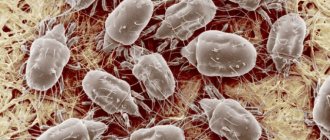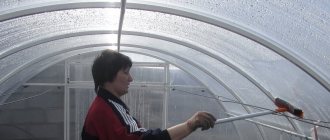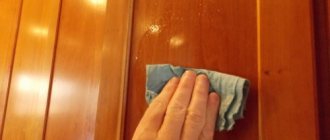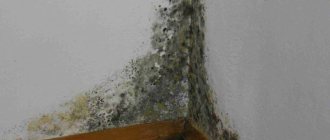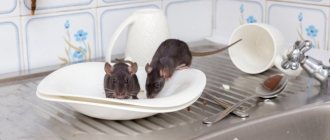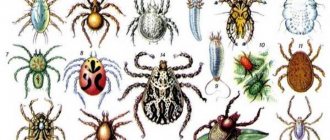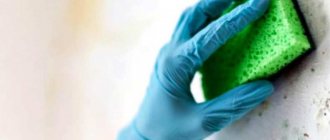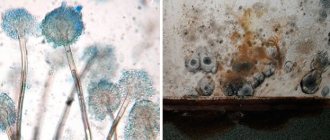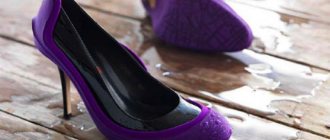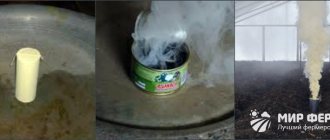Only blue cheese goes well, but in all other cases mold is an extremely undesirable phenomenon. Especially if she appeared on the walls. Dealing with it, it turns out, is not as easy as it seems: it has a habit of returning and spoiling the finishing materials and your mood with its presence. You can learn how to get rid of fungus on the walls in an apartment from the article at the link. And if you live in a large private house, then the situation becomes even sadder, because it is quite difficult to keep track of such a large number of square meters. How to get rid of mold on the walls of a private home once and for all? The most effective options will be discussed today.
- What is mold and why is it dangerous?
- Causes of mold;
- Mold control products;
- Chemicals;
- Folk remedies;
- Conclusion.
What is mold?
Mold is a rather noticeable coating formed by mold fungi. They are literally ubiquitous, growing on almost all materials and in all climates. Fungus appears not only on the surface of objects or walls, but also penetrates into surfaces with microscopic threads, so it is not always easy to remove mold.
Most often, mold in the house can be divided into several types:
- Green. Often it affects food products, spreading and contaminating food.
- White. You can find it in flower pots, on wooden furniture, and in bread.
- Sineva. Affects window frames, doors, parquet floors or furniture.
- Black. The most dangerous type of fungus that appears everywhere: tiles in the bathroom, wallpaper in the room, walls, ceiling.
Harm and danger of mold
The fight against black or any other mold must begin with an understanding of the harmful effects of pathogenic fungi on the structure of the house and the human body.
- Fungus gives an unaesthetic appearance to the decoration of a living space. It is impossible to sell a house with signs of mold damage.
- Mold first grows on the surface - on wallpaper, decorative plaster, painted areas. Then it penetrates deeper, destroying the house little by little. This is especially true for the wooden parts of the building. The decay products of wood fibers attract pests, such as wood borers.
- Spores (tiny seeds) of fungi are the strongest allergen. At risk are people with weakened immune systems, those undergoing chemotherapy, children, the elderly, and pregnant women.
- Mold causes a number of unpleasant and even dangerous diseases for humans:
- food poisoning;
- rhinitis, sinusitis;
- pulmonary diseases, from bronchitis and pneumonia to asthma;
- exacerbation of chronic diseases.
Controversy
Causes of mold
Mold in the home begins to actively multiply and grow only when it gets into a suitable environment.
- The ideal humidity level is 60-80%. This level can be in a bathroom or shower stall.
- Plaque survives both very high temperatures and extremely low temperatures. The most optimal range is from 4 to 20 °C.
- Difficulties in air circulation: piled up furniture, heaps of mismatched things, closed windows - the air is increasingly contaminated with spores, and it becomes much easier for the fungus to multiply.
Why is black mold dangerous in the house?
So, when the walls, floor, and ceiling are affected by black mold, unpleasant dark spots appear in the corners of the room, which gradually take over more and more territories. If measures are not taken to remove it in a timely manner, the wallpaper begins to peel off, the wooden parts of the interior rot, the paint falls off in whole pieces, even concrete floors can crumble and become unusable.
Aspergillus nigra spores (black mold fungus) are one of the possible causes of the development or exacerbation of diseases such as:
- myocarditis;
- rhinitis (allergic);
- meningitis;
- asthma;
- pneumonia.
When contaminated air is inhaled, the fungus enters the respiratory system and enters the bloodstream through the lungs. The blood vessels carry the spores throughout the body. A weakened immune system reacts to mold with symptoms of severe intoxication.
What you need to prepare for a successful fight
Before starting an unequal battle with the ubiquitous fungus, arm yourself with the following means:
- For your protection: gloves, glasses, respirator.
- For mechanical removal: sponge, brush, rag, scraper, sandpaper, water container, detergent or cleaner, garbage bag.
- For final treatment: wood varnish, spore killer.
- Before you begin processing, put on goggles, gloves, a respirator, and a special suit will not be superfluous.
Important! Remember that inhaling spores is very harmful to health. The respiratory organs and skin take the brunt. After the procedure, wash your hands and body. At the first feeling of discomfort, consult a doctor.
How to get rid of mold
Mold in an apartment is destroyed using the following simple algorithm:
- Mechanical cleaning of the affected area from plaque that has appeared.
- Treatment against mold with a special agent over the entire surface, including nearby meters.
- Drying the surface and ventilating the room.
- Prevent plaque re-formation by controlling humidity and air circulation.
Useful tips for mechanical cleaning
- The most important thing is to thoroughly remove visible plaque. If the layer is fresh and has appeared recently, then you can eliminate mold from the walls with a sponge or brush using a regular soap solution.
- It seems possible to remove mold from wallpaper only at first. If the layer has become ingrained, then it must be removed by cleaning it down to the plaster.
Important! You can’t hesitate, because household mold can penetrate through the plaster to concrete and brick in just a year.
- During the removal process, wet the wall, this will prevent spores from spreading through the air.
- You can remove fungus on a wall whitewashed with lime using a scraper or sandpaper. Don't forget to wet the ceiling or wall before starting.
- Mold in the bathroom prefers to settle in the seams between tiles or in joints near plumbing fixtures. Use a scraper to clean the affected area and go over the seams with sandpaper. Dry, apply disinfectant, and reseal the areas between tiles and joints with sealant and grout.
Important! Immediately place all dirty residues in a sealed bag rather than scattering them on the floor. This will prevent the fungus in the bathtub from spreading further.
Which fungal remedy should I choose?
Let's move on to the main question: what is the best remedy for mold on the walls to prevent it from appearing again over time? Here is a list of the most effective drugs, each of them copes well with all types of fungus. Your task is to choose exactly the product that is right for you.
- Bleach. Will help clean mold from tiles or glass, but is not suitable for all porous materials. It is toxic, so it must be used with extreme caution. You need to dilute the bleach with water in a ratio of 1/10. It is better to apply with a wide brush or spray.
- Vinegar. Helps fight against mold on all surfaces and materials. It has a pungent odor and can damage furniture or wallpaper, affecting the color. Spray vinegar or apply it to the surface with a rag. After a week, repeat the procedure for prevention.
- Lemon juice or citric acid. It has the same properties as vinegar, but besides that, it smells nice. Any materials can be processed, and tiles are washed most efficiently. For a glass of water, use 1 tablespoon of juice or acid. After this, the surfaces are completely processed.
- Hydrogen peroxide. The optimal remedy, since removing mold using this method is convenient and safe. Peroxide is applied to any surfaces except actively painted ones (the color may fade). Use a rag or spray. After a week, repeat the procedure again.
- Baking soda. Removing mold with baking soda is effective and safe. Dissolve a tablespoon of baking soda in a glass of water. Spray or rub over the infected area. After an hour, wipe the wall with water again to avoid streaks.
- Prepare an interesting and very effective solution. Take 100 ml of water, 50 ml of vinegar, 50 ml of hydrogen peroxide, 25 ml of boric acid. Combine these components in a container and heat over a fire to 50-70 degrees. Spray or rub this product over the infected area. Repeat the manipulation once every couple of days for the purpose of prevention. This method is the most effective for cleaning tile joints.
How does humidity affect biological contaminants?
The second problem that appears due to increased humidity is the increased growth of microorganisms - that is, mold, bacteria, viruses, mites. If the relative humidity exceeds 60%, these are already favorable conditions for their reproduction. And all microorganisms have an extremely negative effect on our health.
Impact of humidity levels on indoor air quality
Take, for example, mold fungi, which are found in the air in the form of spores. Metabolic products and fragments of dead mold cells cause serious health problems. Including mycotoxicosis, sensitive pneumonia, allergies.
Mold also produces gases as it metabolizes. They contain volatile organic components with a characteristic odor. Fungal spores also contain toxins, which often cause breathing problems. And much more serious than allergies. Due to their very small size, mold spores can easily enter a building through any opening. And on surfaces with an optimal level of moisture, entire colonies multiply.
Mold fungus feeds on substances that are dissolved in water. Therefore, damp walls are his home. It reproduces in moisture levels between 11% and 92%, but the surface must be damp or moist. Therefore, special attention is always paid to corners and other places where water accumulates and stagnates. After all, it is precisely this that promotes the proliferation of microorganisms that prefer a damp surface.
As for temperature, mold grows in the range from 0° to +40°. When the level is below zero, it does not die, but growth stops. But at temperatures above +40°, mold does not live long.
Conditions for mold growth
Thus, in order to prevent the proliferation of mold fungi, two points must be taken into account. The first is to control air humidity. The second is to eliminate the possibility of water vapor condensation inside and outside the walls of the house. These two issues can be resolved in different ways, which we will discuss below.
We recommend the product
Recuperator Prana 200C Wi-Fi 7 reviews
In stock
Heat recovery efficiency,%: 93 | Heat exchanger material: copper | Installation of external grille: from indoors | Wall module diameter, mm: 200 | Wall thickness from, mm: 500 | Area, m²: 11-20, 21-35, 36-60, 61-95, up to 10 |
How to get rid of mold smell
If you have successfully dealt with the fungus, but you can still smell the mold, use:
- Baking soda. Sprinkle a thin layer of powder over the area where the fungus grew. Leave for 3-4 hours, then sweep or vacuum up.
- Charcoal. Place several containers with coal around the perimeter of the room. After a couple of days, the unpleasant smell will disappear.
- Improved ventilation, home fragrances, aerosols and other incense. These products will finally improve the air in the apartment.
Industrial products for combating mold
The modern chemical industry offers many effective detergents and disinfectants. There are special sprays, gels and powders to combat fungus.
The most popular on the market are:
- Liquid antiseptic Dali - suitable for all types of surfaces. They can be used to treat indoor walls and rehabilitate external outbuildings, basements and attics.
- Fongifluid alpa is a deep-penetrating liquid product that is excellent for both killing mold and preventing its proliferation.
- Liquid fungicide Olympus.
- Biotol spray is intended for anti-mold treatment of rooms with high humidity: kitchens, bathrooms, swimming pools, saunas, baths, laundries, food production facilities.
- Mavix-bio is a complex fungicidal agent. Treatment is carried out in three stages: impregnation, washing and hydrophobization of the surface.
What should I do to prevent fungus from appearing?
If you have already gotten even with all traces of the raid, then the next step is to prevent it from appearing again. To do this, you should study these tips:
- Buy a specialized product. Apply an antimicrobial spray to areas where there was fungus on the wall in the bathroom or any other room. This will prevent the re-population of bacteria and spores. Hardware stores sell anti-mildew paint.
- If the room is humid, making it most vulnerable to spores, then take care of purchasing an electric air dehumidifier. This option is ideal for long-term removal of black plaque.
- Update the insulation system in your home. Often it is poor thermal insulation that becomes the root of the problem. If your walls and floors are susceptible to condensation, then the problem is a violation of heat exchange.
Negative effects of humid air on the external walls of the house
There is only one reason why mold appears in the house - excessive humidity. It is because of her that all the problems arise. Dampness can occur for a variety of reasons, which we'll get to later, but in any case, mold and mildew will still appear. At the same time, it itself has an extremely negative impact, which must always be remembered.
For example, on the external walls of a house. This is best seen in the cold season, when the temperature of the surface of the walls or internal layers is lower than the temperature of the room air. As a result, it reaches the dew point and the process of moisture condensation begins on the walls of the building. This leads to their rapid destruction, loss of aesthetic appearance and, of course, the proliferation of mold, bacteria and other microorganisms.
The main types of mold that can appear in a private home
All surfaces are conventionally divided into 2 types:
- Waterproof. The resulting condensate simply flows down along them. A classic example of such surfaces is window glass.
- Porous. These include brickwork (unless special measures are taken). Water vapor passes through such a wall due to the difference in partial vapor pressure between the inner and outer layers of air.
During the cold season, water vapor that penetrates the wall of the house is cooled there. The process of internal condensation begins, which is even more dangerous than usual. Why? Because it is almost impossible to notice (unlike condensation on the surface of the walls). Ultimately, it damages the wall structure, deteriorates or sharply reduces its thermal insulation properties, and the home owner only finds out about it months later.
We recommend the product
Exhaust fan Maico ECA 100 ipro K 17 reviews
In stock
Finish: matte | Fan noise level, dB: 27, 32 | Air consumption, m³/hour: 78, 92 | Diameter, mm: 100 |
How to “cut off the oxygen” to mold
The right solution to the problem is to get rid of moisture, which fungi love:
- Straighten shower curtains properly and hang towels to dry.
- Keep the bathroom, kitchen and other wet rooms clean and dry. Ventilate the premises.
- If the riser or drain is covered with “mushrooms,” it means there is a pipe leaking somewhere. Leaking communications need to be dealt with immediately.
Mold is dangerous only when the situation is advanced and the path to combat is long and difficult. Armed with our tips, you will deal with the fungus in no time.
Mold damage due to wet walls in basements and crawl spaces
Sources of dampness in the house.
The basement is always a place where there is dampness. As noted earlier, this is an excellent environment for black mold to grow. There is constant condensation on the cold parts of the room. The use of ventilation is not always justified. The walls are almost constantly cold, so ventilation can cause even more damage to the structure. It is best to use special plasters that are not afraid of moisture and dampness. Modern synthetic paints cannot help in this situation.
Moisture can come not only from outside, but also from underground. If you use various chemicals for protection, it is ineffective. If high-quality brick was used during construction, then such a problem should not arise. In most cases, high air humidity in the basement appears due to faulty pits or plumbing. Numerous leaks make it impossible to get rid of the excess. To combat the problem, you should use special waterproof clays, which are laid from bottom to top. An independent method of protection in such a situation is quite simple. You need to decide on the scope of the upcoming work. This will help identify all sources of infection and mold growth.
